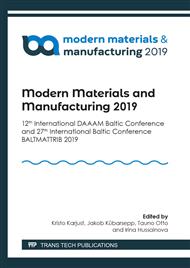[1]
V.S. Ivanova, A.S. Balankin, I.Z. Bunin, A.A. Oksogoev, Synergetics and Fractals in Materials Science, Nauka, Moscow, (1994).
Google Scholar
[2]
B.B. Mandelbrot, The Fractal Geometry of Nature, Freeman, New York, (1982).
Google Scholar
[3]
E. Feder, Fractals, Mir, Moscow, (1991).
Google Scholar
[4]
V.P. Selyaev, T.A. Nizina, Ya.A. Lankina, V.V. Tsyganov, Determination of the fractal dimension as a structural parameter in the analysis of polymer composites. Achievements, problems and promising directions for development building material science theory and practice: Tenth Academic readings of RAASN (2006) 73–76.
Google Scholar
[5]
A.N. Khakhardin, E.I. Khodykin, Fractal dimension of dispersed and porous materials. Building materials. 8 (2007) 62–63.
Google Scholar
[6]
V.P. Selyaev, T.A. Nizina, Ya.A. Lankina, Fractal analysis of the structure filled with polymer composites. News of high schools. Construction. 4 (2007) 43–48.
Google Scholar
[7]
D.D. Khamidulina, I.V. Shishkin, Application of the fractal geometry theory in building material science. Topical issues of the modern science, technology and education. 2 (2015) 5–8.
Google Scholar
[8]
M.V. Bannikov, A.Yu. Fedorova, A.I. Terekhina, O.A. Plekhov, Experimental study of the fractal regularities of fatigue crack growth and energy dissipation at its top. Bulletin of PNRPU. Mechanics. 2 (2013) 21–36.
Google Scholar
[9]
V.T. Pertsev, S.P. Kozodaev, A.A. Ledenev, A.N. Bobryshev, Topological optimization of processes of cement stone and concrete microstructure formation. Scientific bulletin of Voronezh State University of architecture and construction. Series: Physical and chemical issues and modern technologies of building material science. 1 (2015) 21–28.
Google Scholar
[10]
V.P. Selyaev, T.A. Nizina, A.S. Balykov, D.R. Nizin, A.V. Balbalin, Fractal analysis of the deformation curves of disperse and reinforced fine-grained concrete at compression. Bulletin of Perm national research polytechnic university. Mechanics. 1 (2016) 129–46.
DOI: 10.15593/perm.mech/2016.1.09
Google Scholar
[11]
V.P. Selyayev, T.A. Nizina, A.S. Balykov, D.R. Nizin, A.V. Balbalin, Fractal analysis of deformation curves of disperse reinforced fine-grained concrete under compression. PNRPU mechanics bulletin. 1-2 (2018) 84–93.
DOI: 10.15593/perm.mech/eng.2018.1.11
Google Scholar
[12]
N.V. Starchenko, Fractality Index and Local Analysis of Chaotic Time Series. PhD thesis, Moscow, (2005).
Google Scholar
[13]
M.M. Dubovikov, N.S. Starchenko, Variation index and its applications to analysis of fractal structures. Almanac Gordon. 1 (2003) 1–30.
Google Scholar
[14]
M.M. Dubovikov, N.S. Starchenko, M.S. Dubovikov, Dimension of the minimal cover and fractal analysis of time series. Physica A. 339 (2004) 591–608.
DOI: 10.1016/j.physa.2004.03.025
Google Scholar


